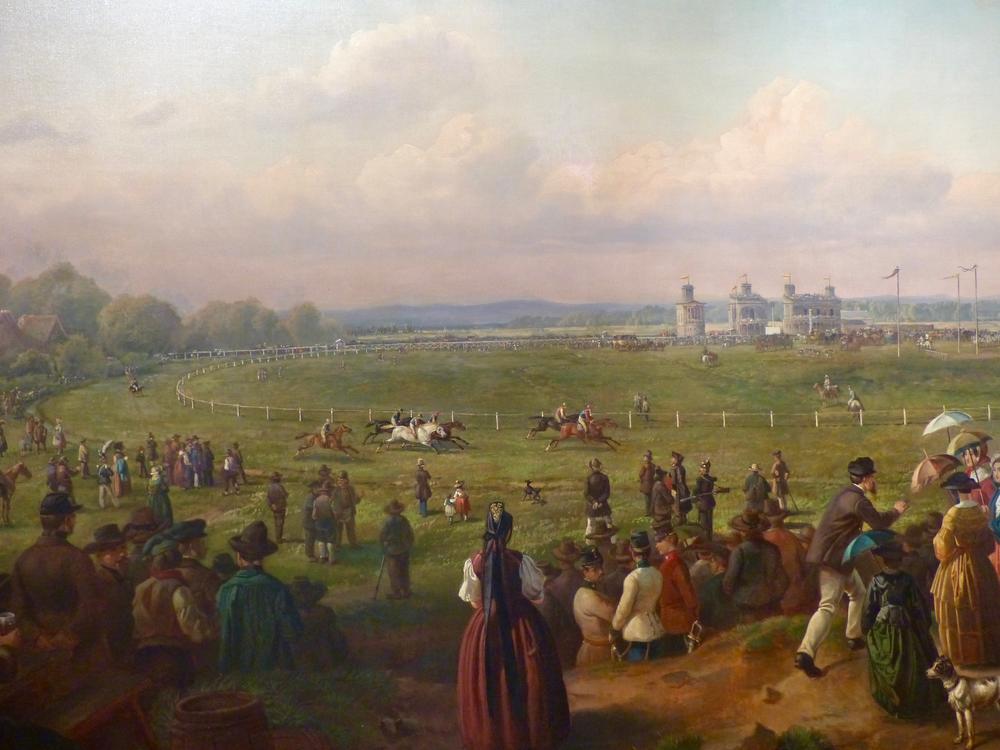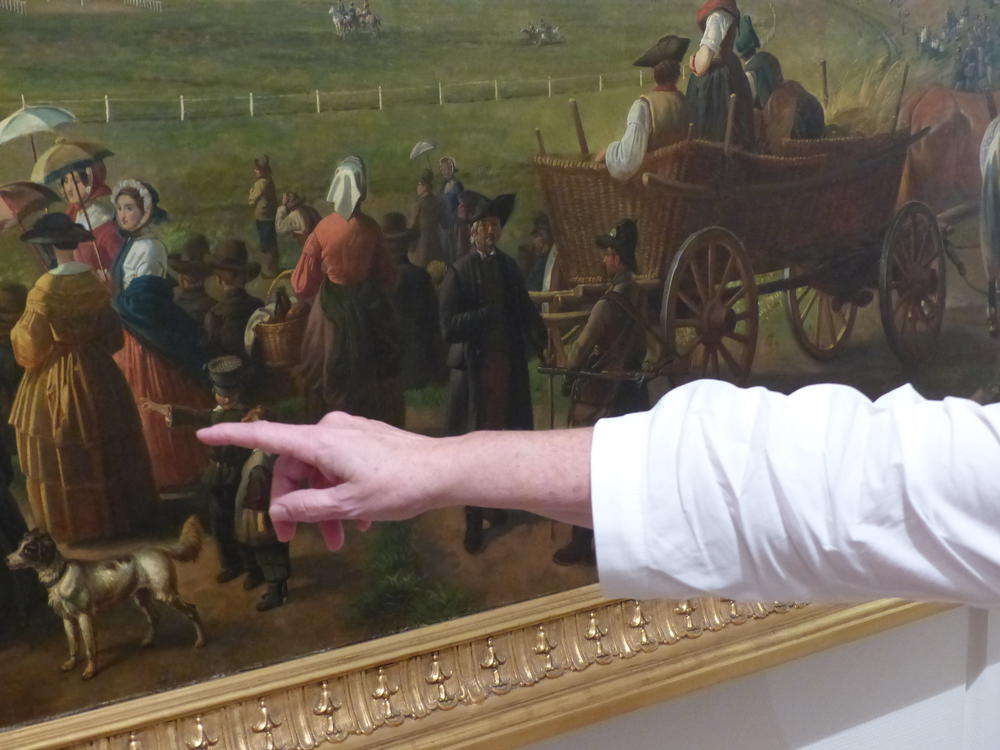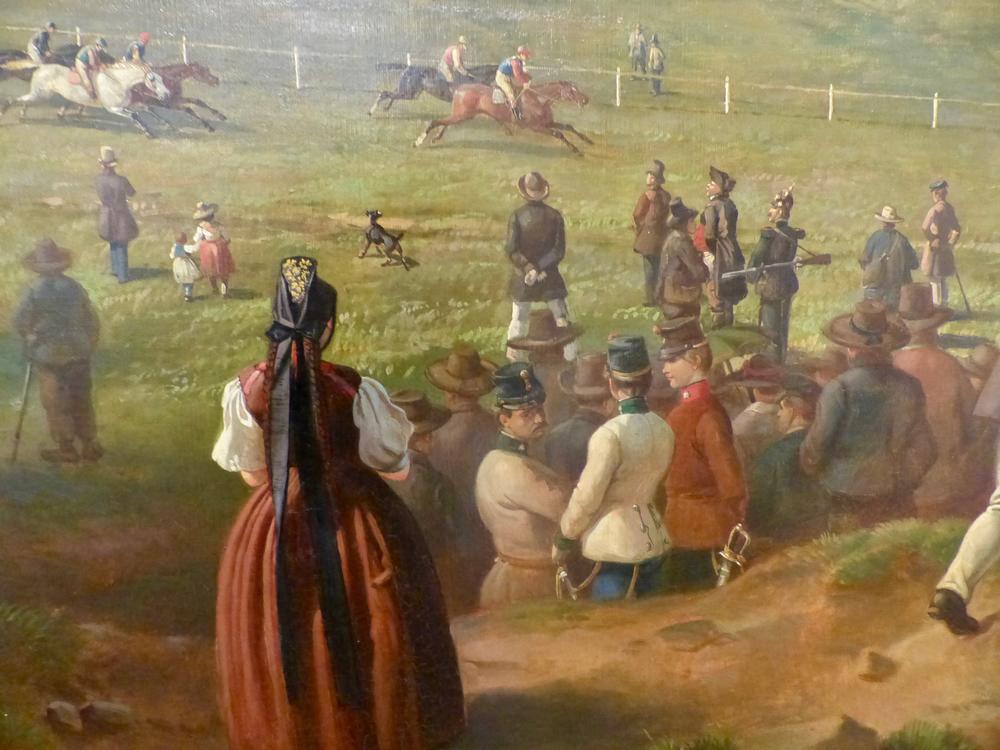Virtual Exhibit No 3: Racecourse Iffezheim. Painting by Johann Baptist Heinefetter (Baden-Baden, GER)
Racecourse Iffezheim. Painting by Johann Baptist Heinefetter (Baden-Baden)
Image Credit: Stadtmuseum Baden-Baden
Interesting angle from which the photograph is taken
Image Credit: Stadtmuseum Baden-Baden / The European Spa
Country People: prominently put in the foreground
Image Credit: Stadtmuseum Baden-Baden / The European Spa
When Edouard Bénazet took over the operation of the casino from his father Jean-Jacques in 1848, he was looking for new attractions to secure Baden-Baden's status as a world-class spa. Bénazet had a racecourse built on a site in the Rhine plain near Iffezheim, modelled on Longchamp, with visitor pavilions for princes and "spectators of higher rank". The first race started on 5 September 1858, they and quickly became the social highlight of the season.
This impressive painting by Johann Baptist Heinefetter (Mainz 1815 - 1902 Baden-Baden) was based on a photograph by the Karlsruhe photographer Charles (Karl) Werzinger, who had a permanent studio in Baden-Baden since 1858. Obviously, the media professional Bénazet recognized the advertising potential of this picture. In the spa paper (Badeblatt) of 5.9.1861, a short notice stated that the painting could be admired in the Conversation House thanks to the kindness of the casino proprietor, and that the photographer had in turn produced prints of it, which were offered for sale on the promenade.
What is interesting is the angle from which the photographer took the scene. From his point of view, he could see the entire racetrack. The buildings (on the left the royal lodge) form the centre of the picture, yet they are in the background. Prominently put in the foreground are those who could not afford the expensive entrance fees - country people, citizens and numerous soldiers, probably from the nearby garrison in Rastatt. Until just a few years ago, the so-called "Kapellenbuckel" (right side in the picture) was the area from which you could follow the race action free of charge.
Curator: Heike Kronenwett
Exhibit No 3: Rennbahn Iffezheim. Gemälde von Johann Baptist Heinefetter aus dem Stadtmuseum in Baden-Baden
Als Edouard Bénazet 1848 den Betrieb der Spielbank von seinem Vater Jean-Jacques übernahm, suchte er nach neuen Attraktionen, um Baden-Baden endgültig zum mondänen Weltbad zu formen. Auf einem Gelände in der Rheinebene bei Iffezheim ließ Bénazet eine Rennbahn nach dem Vorbild von Longchamp mit Besucherpavillons für Fürsten und „Zuschauer höherer Stände“ anlegen. Am 5. September 1858 starteten die ersten Rennen, die sich schnell zum gesellschaftlichen Höhepunkt der Saison entwickelten.
Das imposante Gemälde von Johann Baptist Heinefetter (Mainz 1815 – 1902 Baden-Baden) ist nach einem Foto des Karlsruher Fotografen Charles (Karl) Werzinger, der in Baden-Baden seit 1858 ein ganzjähriges Atelier unterhielt, entstanden. Offensichtlich erkannte der Medienprofi Bénazet das Werbepotential dieses Bildes. Im Badeblatt vom 5.9.1861 wird in einer kurzen Notiz darauf hingewiesen, dass das Gemälde dank der Freundlichkeit des Spielbankpächters im Konversationshaus zu sehen sei und der Fotograf von diesem wiederum Abzüge erstellt habe, die auf der Promenade zu kaufen seien.
Interessant ist der Blickwinkel, aus dem der Fotograf die Szenerie aufgenommen hat. Von seinem Standpunkt aus konnte er die gesamte Rennbahn überblicken. Die Gebäude (links die Fürstenloge) stehen im Mittelpunkt des Bildes, sind aber dennoch weit in den Hintergrund gerückt. Prominent im Vordergrund stehen und vergnügen sich diejenigen, die sich die teuren Eintrittspreise nicht leisten konnten – Landleute, Bürger und zahlreiche Soldaten, wohl aus der nahegelegenen Garnison in Rastatt. Noch bis vor wenigen Jahren war der sog. „Kapellenbuckel“ (re. im Bild) der Bereich, von dem aus man das Renngeschehen kostenlos verfolgen konnte.
Kuratorin: Heike Kronenwett



